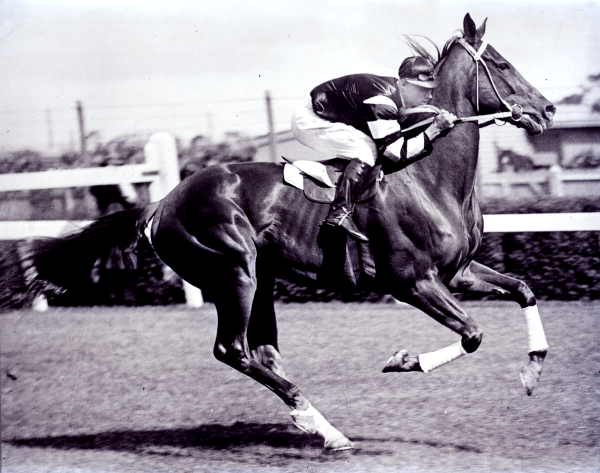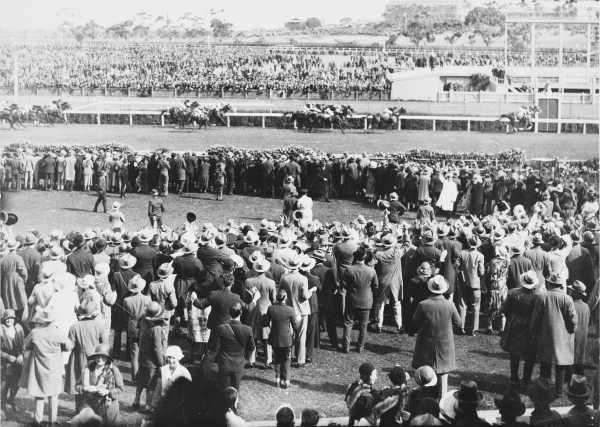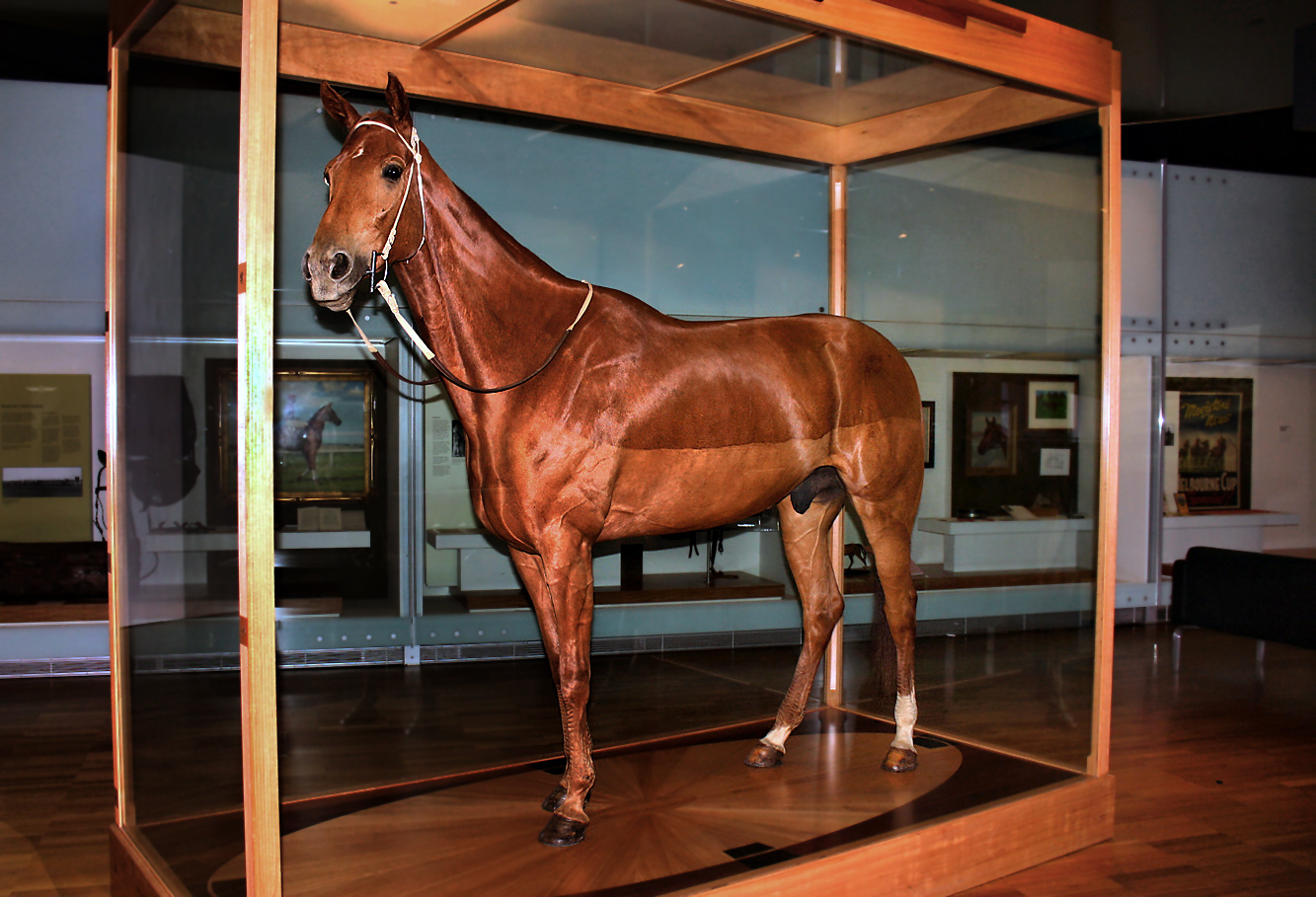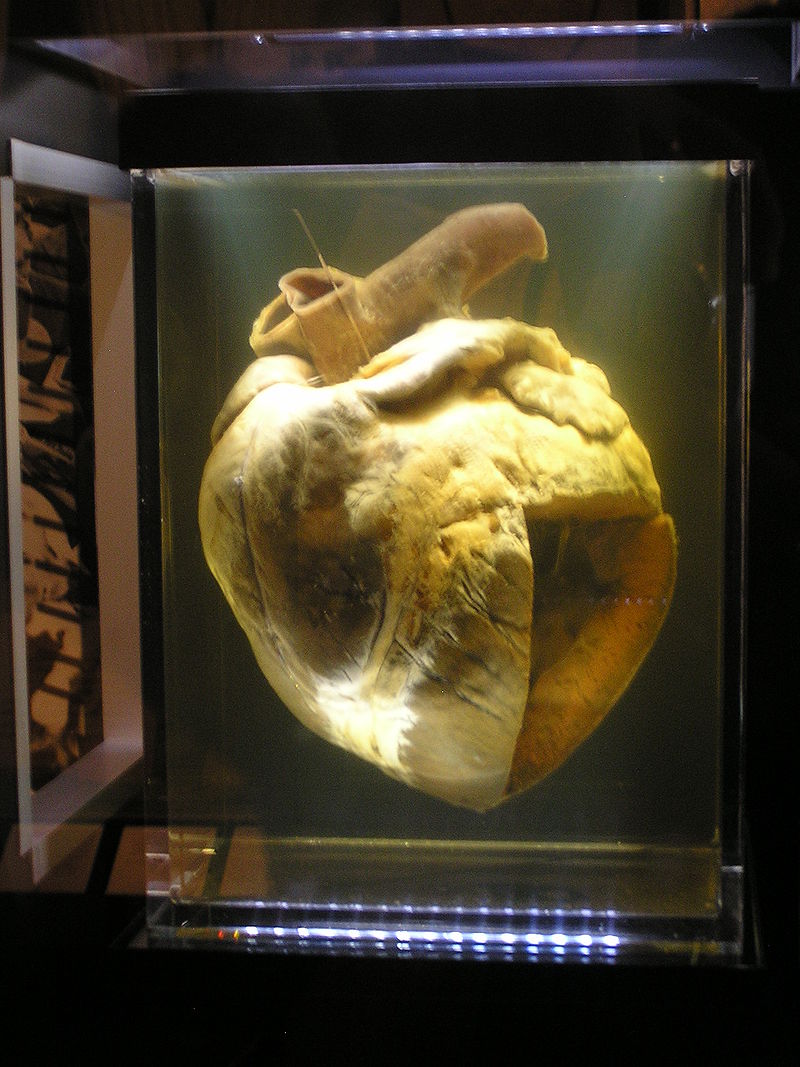A Foal

Phar Lap was foaled at Seadown Stud, near Timaru, in New Zealand to English sire Night Raid and local mare Entreaty. Phar was born on October 4, 1926, and though he went on to become a champion, he was often regarded as “too big”, “ungainly” and referred to as a “giraffe” or “ugly duckling on the racecourse”.
Australian trainer Harry Telford persuaded American businessman and horse owner David J. Davis to buy the colt at auction for 160 guineas (Around £168 back then) based on his pedigree. When Davis purchased the horse he thought he had landed a great deal, only to be left furious when Phar arrived in Sydney.
Phar’s face was gangly, covered with warts and the horse had an awkward gait. Davis was so unimpressed with the horse that he refused to pay to train the horse. This led Telford, who hadn’t been particularly successful as a trainer, to make a deal with Davis: he would train Phar at no cost in exchange for a two-thirds share of any winnings.
Davis agreed and Telford paid for Phar’s training out of his own pocket. Phar, who was known back then as the colt from ‘Lot 41’, was registered under the name Phar Lap on December 3, 1928.
‘Phar Lap’
There are several theories surrounding the origin of Phar Lap’s name and its meaning. The most common theory is that it translates to “lightning” or “wink of the skies” in Siamese or Thai. There are also rumours that Aubrey Ping, a University of Sydney medical student of southern Chinese descent who enjoyed watching horse races, suggested the name.
Phar Lap’s First Race
After some training, Phar Lap entered his first race, the Nursery Handicap, at Rosehill on February 23, 1929. To Davis and Telford’s disappointment, Phar came last. The disappointment only continued as Phar failed to place in his next three races. However, the horse’s luck changed on April 27, 1929, when he won his first race, the Maiden Juvenile Handicap at Rosehill, with 17-year-old rider Jack Baker of Armidale.
Despite his win, Phar didn’t race for several months. His training continued and in the Spring of 1929, Phar entered several races and began to rack up some attention. When he placed second in The Chelmsford Stakes at Randwick on September 14, 1929, the racing community finally began to treat the horse with respect.
Following this, Phar Lap began making a series of wins. He came in first place at the Rosehill Guineas on September 21, 1929, the Australian Derby on October 5, 1929, the Craven Plate on October 10, 1929, and the Victoria Derby on November 2, 1929.
In the same month, Phar narrowly missed a major win after coming third in the VRC Melbourne Cup. Interestingly enough, the horse that placed first was Nightmarch, his half-brother from the same sire. The loss was blamed on inexperience on both the horse and rider as Phar’s regular rider, Jimmy Pike, was changed at short notice. Another loss followed when Phar Lap came third at the St George Stakes on February 15, 1930.
However, his success quickly returned as Phar won an additional nine matches between February 1930 and May 1930. His wins contributed to his overall fame and people around the world had begun to notice Phar Lap, earning him the nicknames ‘Big Red’ and ‘Red Terror’. Unfortunately, international fame also brought danger to the horse.
The Assassination Attempt
As Phar Lap’s popularity grew, so did the number of people who wanted to end the horse’s success. On the morning of November 1, 1930, a group of criminals attempted to shoot Phar Lap days before The Melbourne Cup, Australia’s most famous annual Thoroughbred horserace.
The criminals attempted to shot Phar Lap from their passing car after he had finished a training race. Luckily enough, the criminals missed. The incident was reported in an edition of The Argus on November 3, 1930, which recalled how Aaron Treve Woodcock (Misprinted in the newspaper as ‘Trive Woodcock’), the foreman of the stables, noticed a group of men acting strangely in a blue double seater car.
Woodcock, generally known as ‘Tommy’, was riding his own grey horse and the incident occurred as Woodcock was leading Phar Lap back to the stables. The newspaper report reads:
“When he was near Etna street Woodcock heard the car coming behind him, and he turned sharply into Etna street travelling in an easterly direction. He pushed Phar Lap on to the footpath close to a hedge. By doing so Woodcock placed himself and his grey pony between the racehorse and the car. He saw a man in the car with a double-barrelled shotgun.
The horse was disturbed by the nose of the car, and turned his hindquarters towards it. Woodcock dug his heels into the ribs of the pony, and as Phar Lap felt the pony move sharply forward he gave a jump forward, too. At that moment a shot was fired.
The quick jump forward probably saved Phar Lap from injury, as the shot missed its mark. The car continued on its way, turning from Etna street back into Glenhuntly road and then disappeared.”
Later that same day, Phar won the Melbourne Stakes and three days later, on November 4, 1930, Phar Lap won The Melbourne Cup, making the horse a household name and bringing his fame to an all-time high.
A Champion Racehorse

Before Phar Lap, racing in Australia was known for being the sport of the “filthy rich and the untidy poor” but the horse’s fame made horse betting hugely popular. More and more people were visiting lounge rooms, clubs and pubs across Australia to feel “close” to the action. Back then, most pubs ran an illegal bookie who paid at the “starting price” odds offered by legal bookmakers.
One factor that contributed to Phar Lap’s fame was the Great Depression, which hit after the October 1929 stock market collapse. While people all over the world struggled with money, Phar Lap was breaking records and entertaining thousands. Between September 1929 and March 1932, Phar Lap had run 41 races and won 36 of them.
By early 1932, Phar Lap had won most Australian races and his owners developed an interest in American horse races. They wanted Phar Lap to enter the world’s biggest race, North America’s Agua Caliente Handicap.
Phar Lap was owned by American businessman David J. Davis and was leased to Telford. It was around this time that their three-year lease agreement ended and Telford had enough money to become a joint owner of Phar Lap. Davis shipped Phar Lap by boat to the Agua Caliente Racetrack near Tijuana, Mexico, for the major race, a decision Telford disagreed with. He refused to go, prompting Davis to take Phar Lap’s strapper Tommy Woodcock as his new trainer.
The Agua Caliente Handicap was offering the largest prize money ever offered in North American horse racing history and Phar Lap won the race in record time on March 20, 1932. He was ridden by Australian jockey Billy Elliot. After the win, Phar Lap was sent to a private ranch in California. Sadly, the Agua Caliente Handicap was Phar Lap’s final race as the horse was killed a month later.
Phar Lap’s Mysterious Death
On the early morning of April 5, 1932, Tommy Woodcock found Phar Lap in severe pain and suffering from a high temperature in his stable. Several hours later, Phar Lap haemorrhaged to death in Woodcock’s arms.
An autopsy shortly after his death revealed that his stomach and intestines were inflamed. This led many to believe that Phar Lap had been poisoned. To this day, people are still unsure what caused Phar Lap to die. Many people launched studies and investigations into the horse’s death and found evidence suggesting that he had poisoned on the orders of US gangsters or that he had suffered a bacterial infection.
While nothing was ever confirmed, there are several theories surrounding the horse’s death.
The Theories to Phar Lap’s Death
In 2009, horse specialists studying the necropsies concluded that Phar Lap had died of duodenitis-proximal jejunitis, a bacterial gastroenteritis, otherwise known as infectious diarrhoea.
However, Australian Synchrotron Research scientists claimed in 2006 that Phar Lap had been poisoned with a single large dose of arsenic just hours before he died. This supported rumours that the horse had been murdered by gangsters who feared that the iconic racehorse would inflict large losses on their illegal bookmakers.
Sadly, no evidence suggesting such criminal involvement exists.
A year later, in December 2007, Phar Lap’s name was tested positive for multiple doses of arsenic, supporting evidence that Phar Lap had been poisoned. Then in June 2008, the Melbourne Museum released the findings of the forensic investigation conducted by Ivan Kempson from the University of South Australia and Dermot Henry, the head of Natural Science Collections at Museum Victoria.
According to reports, Kempson analysed six hairs from Phar Lap’s mane and detected arsenic in hair samples, indicating that the chemical had entered the hair cells via the blood. The pair also discovered that Phar Lap ingested a large dose of arsenic 30 to 40 hours before his death.
Suspicion soon fell onto Tommy Woodcock who was accused of mistakenly giving Phar Lap an overdose of stimulants because tonics, which often contained small quantities of cocaine, coffee and arsenic, were given to racehorses to boost their performance. However, the Sydney Morning Herald published an article in October 2011 in which New Zealand physicist Graeme Putt uncovered an article from the Hobart Mercury in which Woodcock denied giving Phar Lap a tonic.
According to reports, Woodcock said in the article: “At first I used to argue that a horse like Phar Lap did not want a tonic, but as time went on I adopted tactics. To please Telford, I would take the bottle, but would pour a quantity down the drain each day so he would think that I was carrying out his instructions.”
Instead, Woodcock was convinced that Phar Lap had been poisoned after experiencing the “violent and underhand ways” of people in the American racing industry.
Phar Lap’s Legacy

While the reason for Phar Lap’s death remains unclear to this day, his legacy has lived on. Phar Lap has been honoured with a life-sized bronze statue at the Flemington Racecourse in Melbourne. He also has streets named after him in Bossley Park, Sydney, and in Cupertino, California. New Zealand also honoured Phar Lap by naming a grove after him.
His legacy didn’t end there, however, as Phar Lap was one of five inaugural inductees in the Australian Racing Hall of Fame and the New Zealand Racing Hall of Fame.
He also ranked number 22 in Blood-Horse magazine’s Top 100 US Thoroughbred Champions of the 20th Century.
Phar Lap, who is considered a national hero in Australia and New Zealand, was honoured on a postage stamp issued by Australia Post in 1978 and now features in the Australian citizenship test. Meanwhile, a $500,000 life-sized bronze memorial to the horse was unveiled in November 2009 at his birthplace of Timaru.
The horse’s life was also adapted into a highly successful film titled Phar Lap or Phar Lap: Heart of a Nation. The Australian-made movie controversially began with Phar Lap’s death before jumping back in time to retell his entire life story and made over 9,000,000 Australian dollars following its release in 1983.
20th Century Fox bought the rights for American distribution and the firm reportedly spent $300,000 to make changes to the film, removing Phar Lap’s death from the beginning of the film and moving it to the end of the movie. In the movie, Phar Lap was portrayed by Thoroughbred horse Towering Inferno who tragically died by lightning on April 15, 1999.

Phar Lap’s heart, which is known for being larger than most horses, was donated to the Institute of Anatomy in Canberra while his skeleton was donated to New Zealand’s National Museum in Wellington.
His stuffed body was placed on show at the Australia Gallery at the Melbourne Museum and, as part of celebrations for the 150th running of the 2010 Melbourne Cup, Phar Lap’s hide and skeleton were put on an exhibition together at the Melbourne Museum.
The horse’s heart is now held at the National Museum of Australia in Canberra and has become the most requested object by visitors. Despite this, many people are convinced that the heart is fake as it was rumoured to have been cut up during the autopsy.





